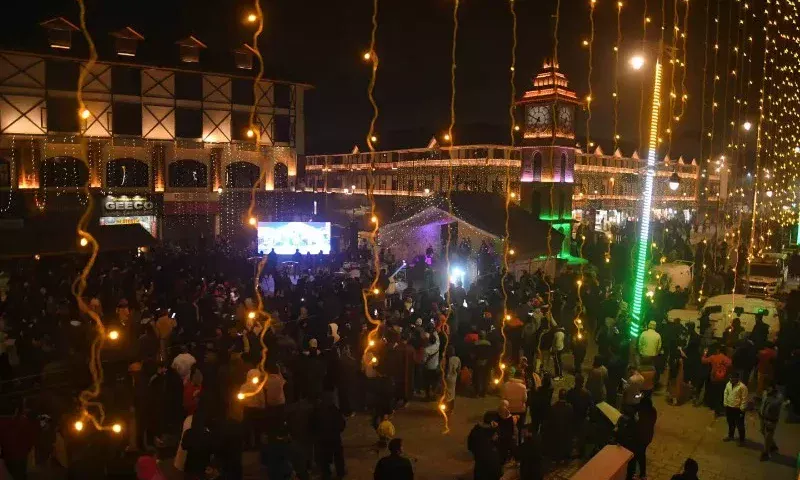The 330 Megawatt Kishenganga Hydro Electric Power Project (KGHEP) in North Kashmir’s Bandipora District is nearing completion as the executing agency has started filling the reservoir to divert water from Kishen Ganga river into Bonar Stream to feed powerhouse located in Mantirgam.
The construction of the over 800 million dollar Hydroelectric Power Project being built along Kishenganga River (Neelam) is in full swing and is expected to complete by January 2018, officials told Kashmir Post.
Over six million cubic meters of water is being stored in the 23.86 meter high dam reservoir to generate 330 Megawatt electricity from three turbines.
The work on the project caught momentum after Prime Minister directed the power ministry and the J&K government to expedite the construction. The PM’s direction came in the backdrop of September 2016 Uri attack.
Earlier in July 2017, reports quote Union power minister Piyush Goyal saying that KGHEP is likely to be commissioned in six months. Goyal said this in reply to a question during a parliament session.
The executing agency Hindustan Construction Company (HCC) has started filling the 23.86 m high concrete faced rockfill dam reservoir in Gurez from July this year to divert (minimum) more 400 cusecs of water at the rate of 45 cubic water per second through a 23 kilometer tunnel to feed three turbines at Mantrigam Bandipora. A maximum gross head of 665 m is proposed to be utilized to generate 1350 Million Units of energy, with an installed capacity of 330 MW(3×110 MW).The project has underground three units of Pelton Wheel Turbines, and each unit has 110 MW capacity.
The different sites including submergence area of project cover an estimated area over 379.07 hectares of forest and non-forest land including 125 hectares forest land, and 254.07 hectares non-forest land.
Senior officers and engineers said that that 96% of the project has been completed. They said that project was expected to be completed by November 2016 but mass public unrest (then) led to the delay.
“The situation in 2016 led to over one and a half year delay, all the operations were halted for over three months or work in Gurez area was also affected,” an officer told Kashmir Post.
“We were not able to move machinery, even workers were not allowed to reach construction sites,” he said.
KHEP is being executed by the public sector National Hydroelectric Power Corporation (NHPC) at a cost of INR 57.8 billion (USD 869 million).
The project started in 2007 is part of a run-of-the-river hydroelectric scheme that is designed to divert water from the Kishanganga (Neelam) River to a power plant in the Jhelum river basin. J&K, Himachal Pradesh, Punjab, Haryana, Uttar Pradesh, Uttaranchal, Rajasthan, Union Territory of Chandigarh and Delhi are the main beneficiary of the project.
The project has been a bone of contention between India and Pakistan with the latter alleging that India’s construction of a dam on Kishanganga, a tributary of Jhelum, will impact water flow on the Pakistan side. Pakistan had also gone to the International Court of Arbitration at The Hague in 2013 but the court ruled in India’s favor stating it has a right to build the dam and divert water from Kishanganga. One of the contentious issues India had with Pakistan was on the height of the dam and a strategy to fill the reservoir that holds over 6 billion cubic meters of water.
Pakistan had strictly opposed water filling strategy that “won’t guarantee its water security to the areas located on Kishenganga(Neelam) river downwards Gurez”.
“We have already incorporated the structures of the dam in a way to release water per requirements by downstream areas located on another side of Kashmir ,” an engineer told Kashmir Post.
It has been reported that Kishanganga project will decrease the power production of the under-construction Neelam-Jehlam hydropower project by 9 percent.
Officers working on the project were confident that the project will be achieved as scheduled in 2018 January.
“We are working hard to meet the planned deadline, a project is well in progress in all aspects and the work is near to completion,” engineers told Kashmir Post.
To generate electricity from the dam, over 6 million cubic meters of water is being stored in the dam reservoir.
General Manager NHPC Amresh Kumar told Kashmir Post that 45 cubic water per second will be diverted through the tunnel.
He said that 6 million cubic meters of water is being stored in 23.86-meter high dam.
“Our workers and engineers are on job and we hope that project will be completed in time,” GM said, adding, “One of the units will begin to generate an initial 110 MW of power in about three months as a test trial which will slowly rise to 220 and then to 330 MW.”
Kishanganga Project nearing completion, power generation by Jan 2018




